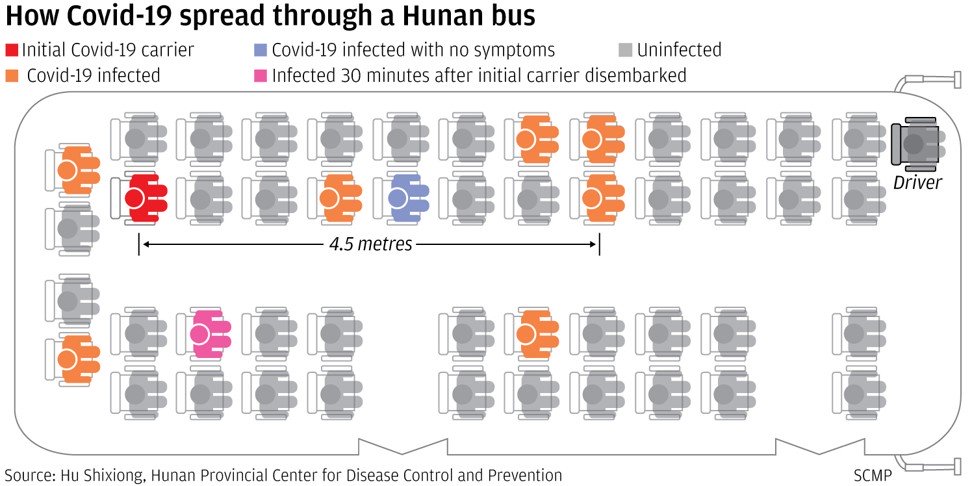
En kinesisk studie visade att coronaviruset (covid-19) kan färdas dubbelt så långt som det avstånd officiella råd rekommenderar. 4,5 meter färdades viruset och det stannade i luften i hela 30 minuter. På ytor av olika material kan viruset överleva i hela 2-3 dygn om förhållanden är gynnsamma.
Studien har dock senare dragits tillbaka, varför förtäljer inte historien.
Övrigt som kan vara bra att veta om Corona / Covid-19 är att:

- barn i regel inte blir så sjuka, dvs ju yngre och friskare, desto mindre orolig behöver man i regel vara. Barn uppvisade färre symtom än vad många vuxna gör i en studie. Barnen hade framförallt hosta, halsont och nästäppa till skillnad från vuxna som även kan få muskel- och huvudvärk, slöhet och i värsta fall även andningssvårigheter. Inga av dessa allvarligare symptom drabbade alltså barnen. Dessutom visade inget av barnen tecken till lunginflammation på de röntgenundersökningar som gjordes, vilket annars kan vara en allvarlig följdsjukdom av covid-19.
- gravida kvinnor som bär på covid-19 tycks vanligen inte föra över sjukdomen på sina bebisar (Det visar två kinesiska studier)
- för de flesta är inkubationstiden (den tid det tar från smittotillfället till sjukdomsutbrott) ca 5 dygn – Det är mediantiden för utbrottet hos de fall som granskats i en ny studie. Man har satt 14 dagar som en säkerhetsmarginal, men 97,5 procent av dem som smittats började enligt studien uppvisa symptom inom 11,5 dagar.
- De vanligaste symtomen är Feber (88 procent av fallen), Torrhosta (68 procent), Stor trötthet (38 procent), Andningsbesvär (19 procent). Se även bild. Men en del kan även drabbas av diarré/magbesvär
- 80 procent av dem som får sjukdomen får milda eller måttliga symtom. En del av dem som får de mildaste symtomen upplever inte ens att de är sjuka. Hur svårt man drabbas beror på ens eget allmäntillstånd och hur stor virusdos man utsätts för.
- Den vanligaste smittvägen är droppsmitta, alltså när folk hostar
- Coronavirus utgör en särskild virusfamilj och är vanliga anledningar till förkylning. De fyra vanligaste av dem som smittar människor etablerar sig bara i de övre luftvägarna (hals, munhåla, näsa) och ger upphov till ungefär en fjärdedel av alla vanliga förkylningar.
- Sedan 2003 finns tre värre varianter av Corona, som även sätter sig i lungorna: sars, mers och det nya coronaviruset (sars-cov-2). Det nya coronaviruset verkar föröka sig mest i näsa och hals, snarare än i lungorna. Det gör att det är mindre farligt än sars och mers men också mer smittsamt.
Ur studien:
“Coronavirus can travel twice as far as official ‘safe distance’ and stay in air for 30 minutes, Chinese study finds
– Authorities advise people to stay 1-2 metres apart, but researchers found that a bus passenger infected fellow travellers sitting 4.5 metres away
– The scientists behind the research said their investigation also highlighted the importance of wearing face masks because of the length of time it can linger
The coronavirus that causes Covid-19 can linger in the air for at least 30 minutes and travel up to 4.5 metres – further than the “safe distance” advised by health authorities around the world, according to a study by a team of Chinese government epidemiologists.
The researchers also found that it can last for days on a surface where respiratory droplets land, raising the risk of transmission if unsuspecting people touch it and then rub their face.
The length of time it lasts on the surface depends on factors such as temperature and the type of surface, for example at around 37C (98F), it can survive for two to three days on glass, fabric, metal, plastic or paper.
These findings, from a group of official researchers from Hunan province investigating a cluster case, challenge the advice from health authorities around the world that people should remain apart at a “safe distance” of one to two metres (three to six and a half feet).
Their work was based on a local outbreak case on January 22 during the peak Lunar New Year travel season. A passenger, known as “A”, boarded a fully booked long-distance coach and settled down on the second row from the back.
The passenger already felt sick at that point but it was before China had declared the coronavirus outbreak a national crisis, so “A” did not wear a mask, nor did most of the other passengers or the driver on the 48-seat bus.
Several passengers became infected during the four-hour bus journey.
China requires closed circuit television cameras to be installed on all long-distance buses, which provided valuable footage for researchers to reconstruct the spread of the virus on the bus, whose windows were all closed.
“It can be confirmed that in a closed environment with air-conditioning, the transmission distance of the new coronavirus will exceed the commonly recognised safe distance,” the researchers wrote in a paper published in peer-review journal Practical Preventive Medicine last Friday.
The paper also highlighted the risk that the virus could remain afloat even after the carrier had left the bus.
The scientists warned that the coronavirus could survive more than five days in human faeces or bodily fluids.
They said the study proves the importance of washing hands and wearing face masks in public places because the virus can linger in the air attached to fine droplet particles.
“Our advice is to wear a face mask all the way [through the bus ride],” they added.”

Lämna ett svar